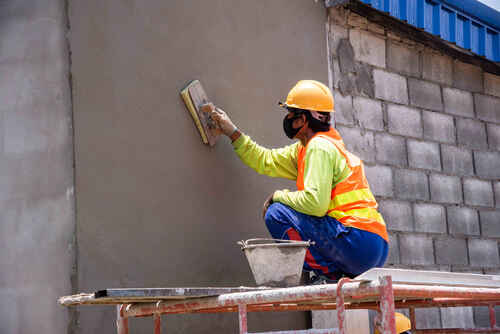Necessary Tools and Methods for Professional Plastering at Home
Wiki Article
A Comprehensive Overview to Learning Plastering Abilities for Your Restoration Demands

Important Tools and Products
Numerous essential devices offer unique purposes, making sure effectiveness and accuracy throughout the smudging process. A top quality trowel, for circumstances, is vital for smoothing and applying plaster, while a hawk supplies a secure system for holding the material.In addition to devices, picking the best plastering products is important. Gypsum-based plasters are commonly favored for their flexibility and convenience of use, while cement-based choices are excellent for exterior applications because of their sturdiness. Water and bonding representatives play significant functions in attaining proper consistency and bond, ensuring that the plaster adheres effectively to the surface area.
In addition, safety equipment such as gloves, goggles, and masks is necessary to protect versus dirt and irritability throughout the application process. By setting up the appropriate mix of devices and materials, plasterers can enhance their ability and create high-grade coatings, ultimately elevating the overall craftsmanship of their job.
Preparing Surface Areas for Gluing
Accomplishing a smooth and sturdy plaster surface begins with precise preparation of the surface areas to be glued. This foundational step is vital to making certain adhesion and the long life of the plaster. Start by assessing the problem of the substratum-- whether it is drywall, concrete, or masonry-- eliminating any loosened paint, dirt, or debris that might hinder bonding.Following, repair any type of imperfections such as splits or openings. Make use of a suitable filler to attain a level surface area; this can be vital for stopping future issues. As soon as repaired, make certain the surface area is tidy and dry, as wetness can endanger plaster adherence.
For porous surface areas, it is recommended to apply a bonding agent. This product improves bond and produces a reputable user interface in between the plaster and substrate. If collaborating with formerly plastered surfaces, it may be required to mess up or sand the area gently to provide a trick for the brand-new plaster layer.
Gluing Techniques and Tips
Mastering gluing strategies needs both skill and method to accomplish a perfect coating. One vital method is the application of the plaster in multiple thin layers, rather than a solitary thick layer. This technique enables for much better bond and reduces the danger of breaking. Beginning with a base coat, guaranteeing it is uniformly spread out and leveled with a hawk and trowel. Utilize a straightedge to look for any kind of blemishes prior to moving on to succeeding layers.When using the coating layer, utilize a shoveling method that involves holding the trowel at a small angle and functioning in a circular activity. This helps to produce a smooth surface and decreases the appearance of trowel marks. Additionally, keep a spray container of water useful to mist the surface area lightly; this keeps the plaster workable and enables smoother finishing.
Timing is essential; job efficiently, as the plaster begins to set. Once check this site out the plaster has actually tightened but is still wet, utilize a damp sponge to gently smooth the surface area additionally. Last but not least, permit sufficient drying time before sanding or painting, guaranteeing your effort causes a specialist, top quality coating.
Typical Errors to Prevent

An additional typical error is applying plaster also thickly. Overzealous applications can result in cracking and prolonged drying times. It's necessary to apply get more plaster in thin, even layers, enabling each layer to completely dry sufficiently before including more.
In addition, not using the right devices can hinder the high quality of the surface. Utilizing unsuitable trowels or mixers can create inconsistencies in the gluing procedure. Constantly select high-quality tools created for gluing tasks.
Last but not least, numerous individuals underestimate the value of timing. Operating in inappropriate temperature levels or moisture levels can negatively influence plaster healing and drying. It is a good idea to check climate condition and adapt your schedule accordingly.
Ending Up Touches for an Expert Appearance
The final phases of a plastering job are essential for achieving a sleek, expert appearance. When the plaster has actually dried out completely, the following step is to evaluate the surface for blemishes.After fining sand, it's advisable to clean the surface to remove any type of dust and particles. A moist fabric works for this function, adhered to by a comprehensive drying period. If necessary, applying a slim layer of completing plaster can boost the surface area even more, offering a smooth finish.
Once the ending up plaster is completely dry, an additional round of fining sand might be required to attain the preferred level of smoothness. Ultimately, take into consideration using a guide prior to painting or wallpapering, which will boost bond and longevity.
Final Thought
Grasping gluing skills dramatically boosts the quality of restoration projects. An extensive understanding of vital tools, surface area prep work, and efficient methods is critical for attaining professional outcomes.Water and bonding representatives play considerable duties in attaining appropriate uniformity and adhesion, making sure that the plaster sticks efficiently to the surface. Plastering.


Additionally, maintain i was reading this a spray container of water handy to haze the surface area lightly; this maintains the plaster workable and enables for smoother ending up. (Plastering)
If needed, applying a slim layer of ending up plaster can boost the surface area even more, supplying a seamless finish.
Report this wiki page